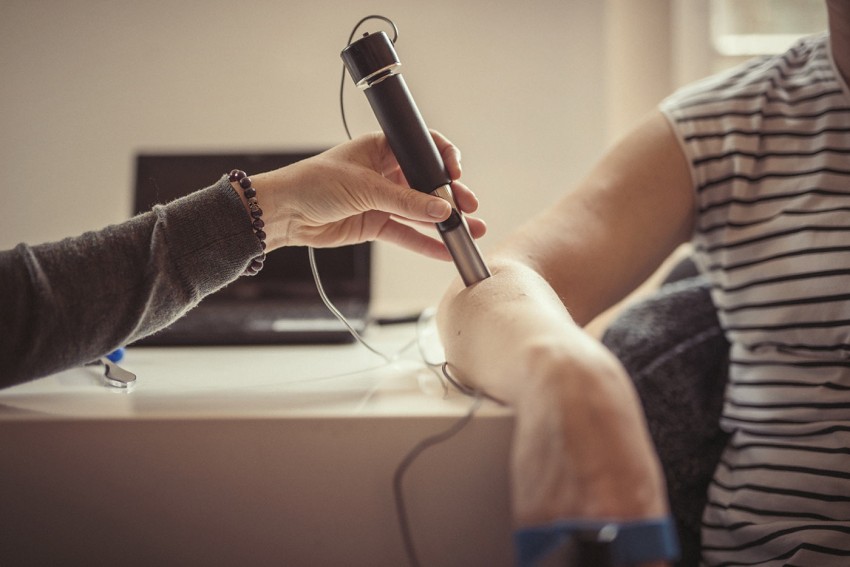THYROFLEX
TentangThyroflex dipatenkan adalah negara non-invasif dari sistem seni untuk menguji, mendiagnosa, dan mengelola kondisi tiroid menggunakan refleks dan gejala untuk secara akurat menentukan fungsi tiroid. Hal ini memungkinkan praktisi untuk menguji fungsi fisiologis pasien, akurat mengevaluasi status kesehatan pasien dan menetapkan pengobatan. Diperkirakan bahwa 80% dari populasi memiliki gangguan tiroid.
Spiral biaya medis telah memaksa banyak praktisi medis untuk mengurangi jumlah alat skrining yang tersedia untuk pasien mereka serta waktu yang mereka habiskan dengan pasien mereka. Tidak hanya masalah biaya alamat THYROFLEX untuk kedua praktisi dan pasien, juga menawarkan bebas rasa sakit, noninvasif pilihan pengujian nyaman dengan umpan balik segera.
Semua tes darah tiroid tidak akurat dalam menentukan fungsi tiroid. Satu-satunya cara untuk menentukan penyakit tiroid adalah dari refleks dan gejala. - menurut Sir Dr. R. I. S. Bayliss sebuah Ahli endokrinologi terkenal dengan Rumah Sakit Lister terkemuka di London, Inggris, Ahli endokrinologi ke Keluarga Kerajaan Inggris
Thyroflex
Aplikasi
Only 18% of the thyroid hormone can be found in the blood. The chances of detecting thyroid disorders in the blood are low because it is not comprehensive enough. It is estimated that 80% of the population has a thyroid disorder.
A blood test measures only the TSH levels, which have limited value in diagnosing thyroid conditions. The TSH levels measured traditionally determine the ‘ideal’ dose of thyroid medication, so it is not surprising that most often patients still remain symptomatic, as blood tests are not a valid medium to determine thyroid function. Many individuals have “normal” TSH levels but suffer from the classic symptoms of hypothyroidism. Most physicians require objective evidence before diagnosing hypothyroidism on the basis of a patient’s clinical symptoms when their blood tests fall within the “normal” range. These sub-clinical hypothyroidism individuals are often denied treatment that would help them manage their condition and symptoms.
Unlike the blood test, the Thyroflex tests the end artifact of the thyroid function (FT3) and it has a 98.5% accuracy rate. The Thyroflex test measures the neurotransmitter speed (brain function), the reflex speed and the resting metabolic rate (RMR). It also takes into account the “Core Hormones” i.e. stress hormones (Cortisol, GABA, DHEA, D3), sleep hormones, Iodine and CoQ10. For this reason, Thyroflex Thyroid Testing is most feasible for making a diagnosis and for determining the optimal dose of thyroid medication for symptomatic patients.
Thyroflex
Ilmu
Refleks lambat
The connection was made late in the 19th century when doctors studying patients with Hypothyroidism observed that clinically hypothyroid individuals have very slow or absent tendon reflexes. The speed at which this reflex reaction occurs is an indicator of cellular function. The lower the speed of conduction, the lower the cellular energy and function.
fungsi sel pada akhirnya dikendalikan oleh T3, hormon tiroid yang paling aktif biologis. Rendahnya tingkat T3 dalam sel mengakibatkan fungsi sel berkurang, yang akhirnya menyebabkan gejala klinis Hypothyroidism. Sejak tes darah tidak dapat mengukur tingkat T3 intraseluler, salah satu cara untuk obyektif menguji fungsi selular adalah dengan mengukur kecepatan di mana impuls saraf dilakukan melalui sel-sel saraf dan otot. Gangguan tiroid cenderung berjalan dalam keluarga, oleh karena itu biasanya turun-temurun. Di sekolah kedokteran, kita semua diajarkan bahwa refleks mempercepat dan memperlambat dengan fungsi tiroid.
Thyroflex
Pembangunan
ikhtisar sejarah pengujian Reflex dengan Achilles
One of the oldest tests for hypothyroidism was the Achilles tendon reflex test in which the rate of relaxation of the calf muscle corresponds to thyroid function. The relaxation is slow in hypothyroid people. Exactly the same slow relaxation occurs in the hypothyroid heart muscle, contributing to heart failure, because the semi-contracted heart can’t receive as much blood as the normally relaxed heart. The hypothyroid blood vessels are unable to relax properly, contributing to hypertension. Hypothyroid nerves don’t easily return to their energised relaxed state, leading to insomnia, parasthesias, movement disorders, and nerves that are swollen and very susceptible to pressure damage.
“Hormon tiroid terus tinggi selular energi, adrenalin rendah, dan refleks yang kuat. Ini tidak diragukan lagi memiliki efek penting pada kedua persepsi dan tanggapan. Memeriksa tingkat relaksasi refleks Achilles adalah cara cepat untuk memeriksa efek tiroid pada saraf dan otot. relaksasi harus seketika, longgar dan floppy. Ada beberapa indikator yang nyaman dari tingkat metabolisme, siklus suhu harian, dan denyut nadi (suhu harus naik setelah sarapan), jumlah air yang hilang oleh penguapan, dan kecepatan relaksasi otot (Achilles refleks relaksasi). Mengukur kecepatan dan relaksasi Achilles tendon refleks kedutan adalah metode tradisional untuk menilai fungsi tiroid, karena dalam hipotiroidisme relaksasi yang tampak tertunda”.
Masuk Woltman Achilles
Tertunda relaksasi refleks peregangan otot (Woltman ini Masuk) Terjadi pada hipotiroidisme. Achilles tendon refleks adalah cara ilmiah untuk menilai fungsi tiroid. kaki harus plantar fleksibel cepat dan kemudian segera kembali ke posisi awal atau di luar tanpa ragu-ragu jika metabolisme sehat. Tidak ada respon atau kembali sangat lambat kembali ke posisi semula adalah indikasi dari metabolisme rendah.
Woltman’s sign of myxoedema, named after Henry Woltman in 1956, is the delayed relaxation phase of the muscle stretch reflex in patients with myxoedema. Although a change in these reflexes was mentioned as being clinically evident possibly as early as the 1870s, no formal description was published until 1924 when William Calvert Chaney objectively quantified the change. Woltman was involved in training Chaney, and it has been proposed that he guided Chaney’s study of these reflexes. Despite the attachment of Woltman’s name to the eponym, little evidence exists that directly links him to the first objective study of the muscle stretch reflex in myxoedema performed by Chaney.
Achilles untuk brakioradialis
Dr. Turner, the inventor, creator, and Intellectual property holder of the Thyroflex, and the ‘Core Hormone’ system, the BioPharma Nutaceuticals, SAM Integrative software analysis for hormones, the Dr Referral System services, initially began development on the Thyroid Reflex research now called the Thyroflex focusing on the Achilles reflex. Then Dr. Turner moved the research and testing to the Brachioradialis, as a more practical test location, the Brachioradialis in the arm, for testing and screening of patients. The Achilles and the Brachioradialis are 99.9% correlated. Clinical trials were then completed over a three-year period on 2,200 people, testing not only the Reflex speed, but also the Neurotransmitters and the Resting Metabolic Rate. (RMR) When we combined the symptoms with the Thyroflex results we were able to offer to other medical practices a precise, integrated system to treat and help their patients with Thyroid disease. The results are proof in and of itself. The Thyroflex is peer reviewed, published, with FDA & CE registration.
The Nitek Thyroflex system has now tested over 1/3 million people, accurately identifying those at risk with thyroid disease. Treating the people identified with Thyroid disorders with the Nitek Core Hormone protocols and the BioPharma medications, and assisting these people to lead a symptom free quality of life. Dr. Turner also discovered in his research and clinical trial endeavors, how to identify Hashimoto’s, how to put it into remission, and how to eventually eliminate the autoimmune disorder helping tens of thousands of people to be auto immune free, and to enjoy life once again.
LET'S TALK ABOUT BLOOD
The TSH blood test is generally considered the most sensitive marker of peripheral tissue levels of thyroid. Many believe this view, however it is incorrect. Some endocrinologists and other physicians erroneously assume that, except for unique situations, a normal TSH is a clear indication that the person’s tissue thyroid levels are adequate (i.e. symptoms are not due to low thyroid). But a more thorough understanding of the physiology of hypothalamic-pituitary-thyroid axis and tissue regulation of thyroid hormones exposes it is clearly erroneous the widely held belief that the TSH is an accurate marker of the body’s overall thyroid status. Therefore, the TSH blood test is not a valid or accurate indicator of thyroid function.
Sebuah penelitian besar yang diterbitkan dalam Jurnal Gangguan BMC Endokrin evaluated the accuracy of TSH by testing 2570 women attending a reproductive endocrine clinic for menstrual irregularities or infertility. The study found that the TSH was a very poor indicator of abnormal thyroid function as over half the women with a TSH between 2 and 4 mIU/L, which would be interpreted as indication of normal thyroid function, were shown to be hypothyroid when the more accurate and sensitive TRH testing was done.
Sebuah studi yang diterbitkan dalam British Medical Journal examined the accuracy of using the TSH as a marker for adequate thyroid replacement. The study found that the TSH was a very poor indicator of optimal thyroid function, and that a suppressed TSH was not an accurate indicator of over-replacement. It was shown that 80% of the time a suppressed TSH was not an indication of hyperthyroidism or over-replacement, and the authors discourage the reliance on the TSH for optimal dosing.
Satu studi tersebut jelas menunjukkan fakta ini diterbitkan dalam Journal of Endocrinology Clinical dan Metabolisme. It was determined how often central hypothyroidism that was confirmed with TRH testing went undetected by standard thyroid function tests. The authors found that 92% of patients with hypothyroidism akan tetap tidak terdiagnosis using baseline thyroid function tests (Blood tests). The authors conclude. “…most prior studies have failed to accurately identify many cases of hypothyroidism because diagnostic criteria require a T4 or FT4 value below the normal range in addition to a low TSH value. However, patients with hypothyroidism most often have normal TSH values and T4 or FT4 levels within the lower part of the normal range”.
catatan: dalam kami sumber, there is a comprehensive review of Blood testing with references, as to why the thyroid blood tests are not valid in determining Thyroid function. As Dr. R.I.S. Bayliss stated, none of the blood tests are valid, the only way to determine thyroid function is Symptoms and reflexes. The Thyroflex, uses symptoms and reflexes, with a 98.5% accuracy rate.
Gangguan tiroid
What Are The Symptoms?
Hypo
*_____ Tiredness & Sluggishness, lethargic
*_____ Dryer Hair or Skin (Thick, dry, scaly)
*_____ Sleep More Than Usual
*_____ Weaker Muscles
*_____ Constant Feeling of cold fingers/hands/feet
*_____ Frequent Muscle Cramps
*_____ Poorer Memory
*_____ More Depressed (mood change easily)
*_____ Slower Thinking
*_____ Puffier Eyes
*_____ Difficulty with Math
*_____ Hoarser or Deeper Voice
*_____ Constipation
*_____ Coarse Hair / Hair loss/Brittle
*_____ Muscle / Joint Pain
*_____ Low Sex Drive / Impotence
*_____ Puffy Hands and Feet
*_____ Unsteady Gait (bump into things)
*_____ Gain Weight Easily
*_____ Outer Third of Eyebrows Thin
*_____ Menses More Irregular (should be 28 days)
*_____ Heavier Menses (clotting / 3+ days)
*_____ Carpel Tunnel Syndrome
Hiper
*_____ Palpitations (Skipping of heart beat)
*_____ Insomnia
*_____ Tachycardia (Rapid or irregular heart beat)
*_____ Shakiness
*_____ Increased Sweating
*_____ Brittle Nails
*_____ Loss of Appetite
Tiroid Fungsi Uji
Perbandingan
Standar
Tes Darah Medis
Panel darah
- Misleading and inaccurate, in classifying the patient with sub-clinical hypothyroidism. 18% accurate
- Costly, out of office blood test, requires 2nd mengunjungi
- Tidak ada pendapatan untuk berlatih Anda
- Measures only the TSH levels or sometimes T3, T4, and on rare occasions FT3, FT4 in the blood which have limited value in diagnosing thyroid conditions
- Not able to identify or provide optimal treatment for a Hypothyroidism, Hyperthyroidism, RT3, and Autoimmune not identified
- Subyektif
- Tidak ada pengobatan yang ditawarkan untuk pasien bergejala
Maju
Thyroflex Uji
Tiroid Fungsi Uji
- 98.5% accuracy rate. Non-invasive, pain-free with fast results
- Cost Effective, in house test and instant results.
- Pendapatan untuk berlatih Anda
- Measurement of conduction velocity through tendon reflex, RMR, and takes into account the evaluation of the symptoms
- Able to diagnose, treat and titrate, Euthyroid, Hypothyroidism, Hyperthyroidism, Autoimmune and RT3
- Bukti objektif
- dosis optimal obat tiroid untuk pasien bergejala
Proses
ThyroflexThe Thyroflex tests for thyroid conditions and further assists in the medical analysis of potential health conditions. The analysis and treatment is integrated through the revolutionary SAM (Software for Age Management). SAM provides health history, health forecasts, health condition management and treatment recommendations as a complete solution. Upon completion of the Thyroflex test, it determines whether the patient is hypothyroid, hyperthyroid, or euthyroid. The results are then uploaded into the SAM system for the next steps to prescribe the treatment according to the thyroid levels.
The thyroid medication needs to be “titrated”, which means to adjust the medications slowly every 30 days until the correct dosage is determined. From historical literature, this means the average patient will be on two to three grains of natural bio identical thyroid (Biothroid), as our protocols recommend you take the patient up one grain at a time, (30 days to equilibrate) this means that the patient would have three to four visits, to be titrated, to dose. Once at dose, we recommend that you allow one repeat (90 days) then retest the patient every 6 months. All of our Nutraceuticals are FDA compliant.

Thyroflex Pengujian Perangkat

Thyroflex Software Solution
Ikhtisar Proses
ThyroflexWe recommend that an initial basic blood test is given to the patient, to check some of the blood markers that can affect the thyroid such as ferritin. Usually about 15% of patients tested require extra blood tests to further assess autoimmune disease, Hashimoto’s, or Graves disease and RT3.
Upon receiving the results, these disorders will require very specific protocols and treatment programs, that have been developed by Nitek. Our protocols first line of defense is to use all natural Bio identical medications. The thyroid medications will be titrated slowly until the correct dose is achieved. Most of the patients start to feel the effects of the medications within 14 days, some patients feel their best when they reach the correct dosage of medications. (For vegetarians, the natural bio identical thyroid hormones we use have no meat connective tissue or fat product in them, only the active Thyroid hormones are extracted, and purified, as a chemical compound).
1. Register patient and complete the online questionnaire 0 %
2. Perform Thyroflex Test (4 mins) 0 %
3. Upload Thyroflex Report to the SAM Software and input other biomarkers 0 %
4. View instant results and review condition management 0 %
5. Review automated treatment recommendation 0 %
6. Print report, provide APP credentials and provide products 0 %
FOR MORE DETAILS ON THE ENTIRE PROCESS FLOW >
THYRODINE
Nitek has the Thyrodine to accurately measure Blood Urine and Saliva. The Thyrodine is an iodine testing system, available on the same basis as the Thyroflex. The test takes one minute. It gives you a Parts Per Million reading in urine that indicates whether the patient is sufficient or deficient. It also gives you parts per million for saliva. Saliva indicates if the patient is up taking the BioDine or if halides or goitrogens are binding to the iodine.



